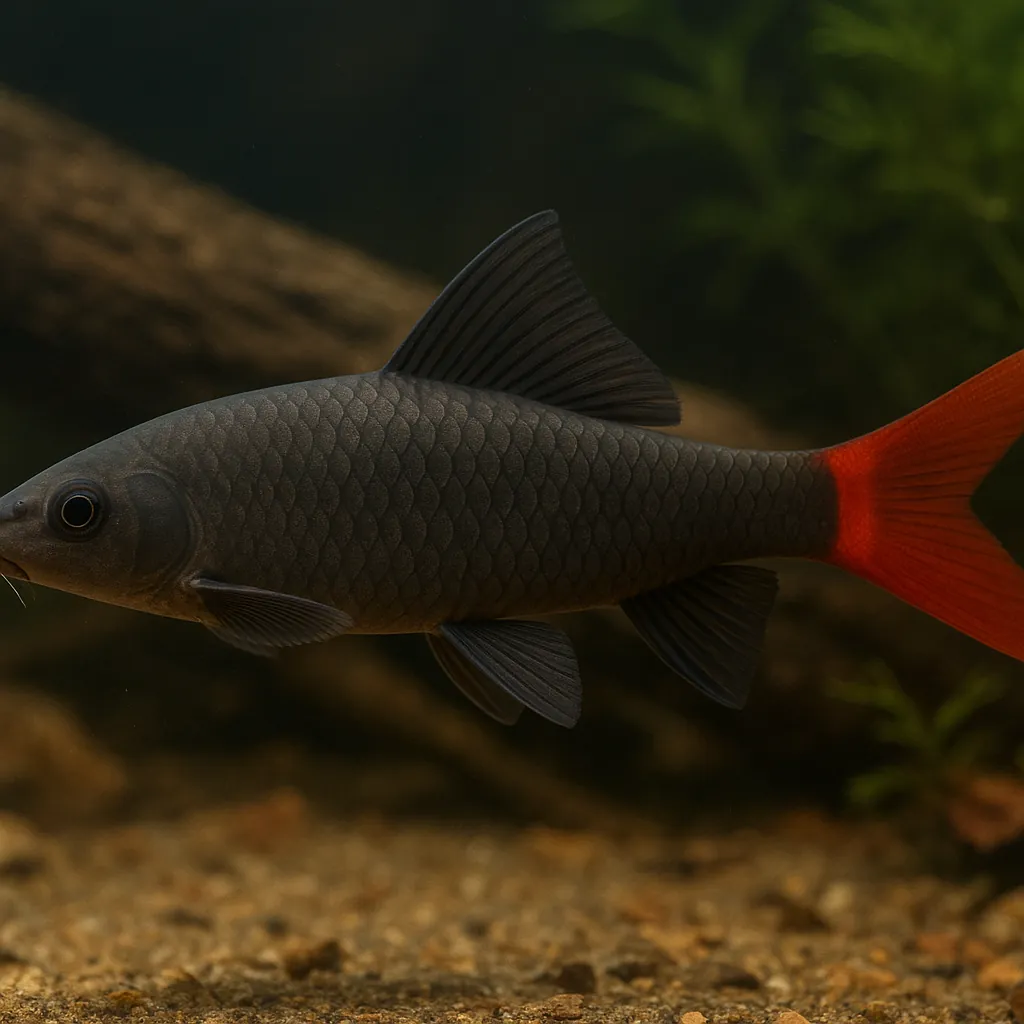
Labeo frenatus
Introduction
The Rainbow Shark (Epalzeorhynchos frenatum), also known as the Red-Finned Shark or Ruby Shark, is a popular freshwater fish among aquarists. Its striking appearance, characterized by a dark body and vibrant red fins, adds a dynamic visual element to home aquariums. While their care requires attention to specific needs, Rainbow Sharks can be a rewarding addition for hobbyists prepared to meet their requirements.
What makes the Rainbow Shark a popular choice among aquarists?
Their unique coloration and active behavior make them an attractive centerpiece in many freshwater tanks.
Are Rainbow Sharks suitable for beginner fishkeepers?
Due to their territorial nature and specific care needs, they are better suited for aquarists with some experience.
Care and Environment
Proper care for Rainbow Sharks involves attention to tank size, water parameters, and tank setup to ensure their well-being.
What is the minimum tank size for a Rainbow Shark?
A minimum tank size of 200 liters is recommended to provide adequate space and reduce territorial behavior.
What are the ideal water parameters for Rainbow Sharks?
Maintain a temperature between 24–27°C, pH levels of 6.5–7.5, and water hardness of 5–11 dH.
How should the tank be set up for a Rainbow Shark?
Include plenty of hiding spots using rocks, caves, and plants to help establish territories and reduce aggression.
Rainbow Sharks are omnivorous and will accept a variety of foods, including algae, small crustaceans, insect larvae, and high-quality flake or pellet foods. Supplementing their diet with blanched vegetables like zucchini or spinach is beneficial.
Regular water changes and efficient filtration are essential to maintain water quality, as Rainbow Sharks are sensitive to poor conditions. Ensure the tank is well-oxygenated with moderate water flow to mimic their natural riverine habitats.
Origin and Habitat
Rainbow Sharks are native to Southeast Asia, specifically the river basins of the Mekong, Chao Phraya, and Maeklong in Thailand, Laos, and Cambodia. They inhabit rivers and streams with sandy or rocky substrates and are known to migrate into flooded areas during the rainy season.
Where are Rainbow Sharks originally from?
They are indigenous to river basins in Thailand, Laos, and Cambodia.
What type of environments do Rainbow Sharks prefer in the wild?
They thrive in rivers and streams with sandy or rocky bottoms and moderate water flow.
Temperament and Compatibility
Rainbow Sharks are known for their territorial behavior, especially as they mature. They can be aggressive towards conspecifics and similarly shaped species.
Can Rainbow Sharks be kept with other fish?
Yes, but it's best to choose robust, fast-swimming species that occupy different tank levels, such as barbs, danios, and rainbowfish.
Is it advisable to keep multiple Rainbow Sharks together?
It's generally not recommended due to their territorial nature, which can lead to aggression.
Providing ample hiding spaces and a spacious tank can help mitigate aggressive behaviors, but careful consideration of tank mates is crucial.
Interesting Facts
Rainbow Sharks have an albino variant, characterized by a white body and red fins, which is also popular among aquarists. In the wild, they are known to migrate into flooded areas during the rainy season, returning to rivers as waters recede. Breeding Rainbow Sharks in home aquariums is challenging due to their territorial nature and specific breeding requirements.
Are there different color variations of Rainbow Sharks?
Yes, the albino variant is a popular alternative with a white body and red fins.
Is breeding Rainbow Sharks in captivity common?
Breeding them in home aquariums is rare and challenging due to their territorial behavior.
Sources
All information in this article has been gathered from the following reputable sources:
Overview
Recommended Tank Size 105.7 Gallons (for optimal conditions) |
Minimum Group Size 1 |
Minimum Tank Volume 52.8 Gallons |
Maximum Adult Length 5.9 inches |
Average Adult Length 4.7 inches |
Shoaling (6+ required) No |
Preferred Water Type Freshwater |
Temperature Range (°C) 24–27 |
pH Range 6.5–7.5 |
Water Hardness (dGH) 5–11 |
Typical Lifespan (years) 5 years |